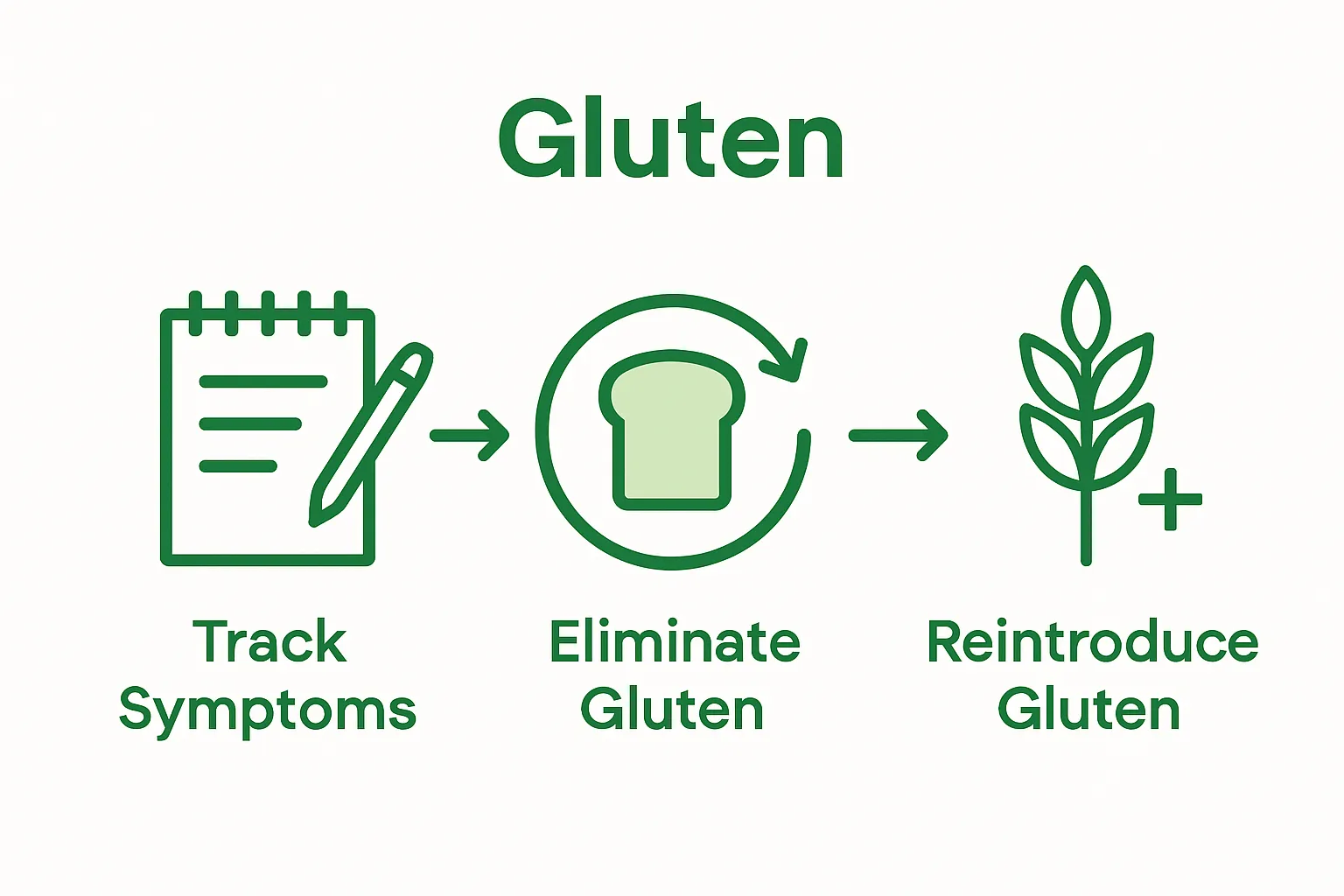Testing for gluten sensitivity sounds straightforward. Around 6 percent of people in the UK report symptoms after eating gluten. Most expect a quick fix from swapping out their bread or pasta. Yet the real discovery starts long before the kitchen clear-out. The most telling signs usually show up in the quiet detail of a daily journal, revealing patterns that surprise even the most health-conscious among us.
Table of Contents
- Step 1: Evaluate Your Symptoms And Diet
- Step 2: Eliminate Gluten From Your Diet
- Step 3: Monitor Symptoms During The Elimination Phase
- Step 4: Reintroduce Gluten Gradually
- Step 5: Assess Your Reaction To Gluten
Quick Summary
| Key Point | Explanation |
|---|---|
| 1. Track Symptoms and Diet Routinely | Maintain a detailed health journal documenting food intake and symptoms to identify patterns relating to gluten sensitivity. |
| 2. Conduct a Gluten Elimination Diet | Remove gluten entirely for four to six weeks, focusing on whole foods to evaluate your body’s responses. |
| 3. Monitor Responses During Reintroduction | Gradually reintroduce gluten sources while carefully tracking any reactions or symptoms to assess sensitivity. |
| 4. Identify Key Reaction Categories | Evaluate distinct responses such as digestive, emotional, and neurological changes when gluten is consumed again. |
| 5. Consult Healthcare Professionals if Needed | If significant symptoms arise, seek medical advice for further evaluation, as self-testing may not replace professional diagnosis. |
Step 1: Evaluate Your Symptoms and Diet
Identifying potential gluten sensitivity begins with a comprehensive self-assessment of your bodily responses and dietary patterns. This crucial first step involves carefully observing and documenting your physical reactions and nutritional intake to establish a clear baseline for understanding your potential gluten-related challenges.
Understanding Gluten Sensitivity Symptoms requires keen self-awareness. According to the Celiac Disease Foundation, symptoms can manifest across multiple body systems and often appear deceptively unrelated. Common indicators include digestive discomfort such as bloating, abdominal pain, constipation or diarrhoea, and less obvious signs like persistent fatigue, unexplained headaches, joint pain, skin rashes, and unexpected mood fluctuations.
Start by creating a detailed personal health journal where you meticulously track your daily dietary intake and corresponding physical and emotional responses. Record everything you consume, noting precise times and any symptoms that emerge within 24-48 hours after eating. Pay special attention to meals containing wheat, barley, rye, and other gluten-rich ingredients.
Your tracking should include specific details such as:
- Precise food items consumed
- Time of meal
- Immediate and delayed bodily reactions
- Emotional and energy level changes
- Sleep quality
- Digestive comfort
Consider conducting an elimination diet as a natural method for testing gluten sensitivity. This approach involves completely removing gluten from your diet for approximately four to six weeks, then systematically reintroducing it while carefully monitoring your body’s response. During the elimination phase, focus on naturally gluten-free whole foods like fruits, vegetables, lean proteins, and gluten-free grains such as quinoa and rice.
As you progress through this self-assessment, be patient and thorough. Individual reactions vary significantly, and what triggers a response in one person might not affect another. If your symptom journal reveals consistent patterns suggesting gluten sensitivity, consider consulting a healthcare professional for comprehensive testing and personalised guidance. Learn more about eating healthy naturally to support your overall wellness journey during this investigation.
Remember, this initial step is about gathering objective data about your body’s unique responses, creating a foundation for understanding your potential gluten sensitivity with scientific precision and personal insight.
Below is a summary table outlining common symptoms of gluten sensitivity and the body systems they may affect, helping you identify potential reactions during your self-assessment.
| Symptom | Body System Affected | Description |
|---|---|---|
| Bloating and abdominal discomfort | Digestive | Feeling of fullness, gas, or pain |
| Constipation or diarrhoea | Digestive | Irregular or uncomfortable bowel habits |
| Persistent fatigue | Systemic | Ongoing tiredness or low energy |
| Unexplained headaches | Neurological | Frequent or recurring head pain |
| Joint pain | Musculoskeletal | Aching or stiffness in joints |
| Skin rashes | Dermatological | Itchy, flaky, or inflamed skin issues |
| Mood fluctuations | Psychological | Irritability, anxiety, or low mood |
Step 2: Eliminate Gluten from Your Diet
Eliminating gluten from your diet represents a critical phase in naturally testing for gluten sensitivity, requiring meticulous planning and comprehensive nutritional strategy. According to the Mayo Clinic, a strict gluten elimination requires carefully removing all wheat, barley, rye, and their derivatives from your nutritional intake.
Understanding Gluten Sources demands more than simply avoiding bread. Gluten hides in numerous unexpected food products, including sauces, processed meats, beer, certain medications, and even cosmetic products. Start by conducting a comprehensive kitchen audit, systematically examining every item in your pantry, refrigerator, and spice collection.
Begin your elimination journey by clearing out potential gluten-containing products. Read ingredient labels meticulously, looking for terms like wheat, barley, rye, malt, brewer’s yeast, and wheat derivatives such as semolina, graham flour, and durum. Replace these items with naturally gluten-free alternatives like quinoa, rice, buckwheat, and gluten-free certified products.

Your elimination diet should focus on whole, unprocessed foods that are naturally gluten-free:
- Fresh fruits and vegetables
- Lean meats and fish
- Eggs
- Nuts and seeds
- Legumes
- Dairy products
- Gluten-free grains like rice and quinoa
Prepare for potential challenges during this transition. Some individuals experience temporary withdrawal symptoms or nutritional gaps when eliminating gluten. Counteract this by ensuring balanced meal planning and potentially consulting a nutritionist to maintain adequate nutrient intake. Explore our guide on choosing organic gluten-free foods to support your dietary transformation.
Practical Implementation Strategies involve meal prepping, carrying gluten-free snacks, and developing a support system. Communicate your dietary changes with family and friends, request restaurant accommodations, and remain vigilant about cross-contamination in shared kitchen spaces.
Verify your elimination protocol’s success by monitoring your symptoms and overall well-being. Maintain your detailed health journal, tracking energy levels, digestive comfort, and any physiological changes throughout this process. Commitment and patience are key to understanding your body’s unique gluten response.
This checklist table provides a quick reference for naturally gluten-free foods to prioritise during the elimination diet, assisting you in maintaining a balanced and safe meal plan.
| Food Category | Example Foods | Key Consideration |
|---|---|---|
| Fresh Produce | Fruits, vegetables | Ensure items are unprocessed |
| Lean Proteins | Chicken, fish, eggs | Choose unbreaded, plainly prepared options |
| Gluten-free Grains | Rice, quinoa, buckwheat | Look for certified gluten-free labels |
| Dairy | Milk, cheese, yoghurt | Opt for plain, unflavoured varieties |
| Legumes | Lentils, beans, chickpeas | Dried or canned without additives |
| Nuts and Seeds | Almonds, sunflower seeds | Plain, with no coatings or flavourings |
Step 3: Monitor Symptoms During the Elimination Phase
The elimination phase demands rigorous and systematic symptom tracking to understand your body’s response to a gluten-free diet. According to the NHS, maintaining a comprehensive health journal is crucial for identifying potential gluten sensitivity patterns.
Developing a Detailed Tracking System requires creating a structured method for recording your daily experiences. Invest in a dedicated notebook or digital tracking app where you can meticulously document every aspect of your health journey. Your tracking should encompass far more than just dietary intake, extending to physical, emotional, and cognitive changes.
Each daily entry should include specific, granular information about your overall wellness. Key Observation Points should capture:
- Sleep quality and duration
- Energy levels throughout the day
- Digestive comfort and bowel movements
- Mood and emotional state
- Physical symptoms like headaches, joint pain, or skin conditions
- Menstrual cycle changes (for women)
- Exercise tolerance and recovery
- Cognitive function and mental clarity
Establish a consistent time for journaling, preferably at the end of each day when your experiences are fresh in your memory. Be brutally honest and objective in your recordings, treating your journal as a scientific document rather than a personal diary. Look for subtle patterns and correlations between your gluten-free diet and physiological responses.
Symptom Tracking Strategies involve creating a standardised rating system for your observations. Consider using a numerical scale from 0-10 for different symptoms, allowing you to quantify your experiences objectively. This approach transforms subjective feelings into measurable data points that can reveal meaningful insights about your potential gluten sensitivity.
Prepare for potential psychological and physical challenges during this elimination phase. Some individuals experience temporary discomfort or emotional fluctuations as their body adjusts to dietary changes. Remain patient and compassionate with yourself, understanding that this process is a form of personal medical investigation. Learn more about understanding your body’s nutritional needs to support your wellness journey.
As you progress through the elimination phase, pay close attention to both negative and positive changes. Improvements in energy, digestion, skin health, or mental clarity can be as informative as persistent symptoms. Your meticulous documentation will provide a clear roadmap for understanding your body’s unique relationship with gluten, preparing you for the next steps in determining your potential gluten sensitivity.
Step 4: Reintroduce Gluten Gradually
Reintroducing gluten is a delicate and critical phase in determining your body’s sensitivity, requiring meticulous planning and careful observation. This strategic step will help you definitively understand how your body responds to gluten after a complete elimination period.
Preparation for Reintroduction involves selecting a controlled environment and timing. Choose a period when you have minimal stress and can closely monitor your bodily responses. Weekends or planned breaks from intense work commitments provide ideal conditions for this nutritional investigation.
Begin the reintroduction process by selecting a single pure gluten source, such as whole wheat bread or plain wheat pasta. Avoid complex foods with multiple ingredients that might complicate your symptom tracking. Start with a small portion equivalent to approximately 1-2 slices of bread or half a cup of wheat-based product.
Your systematic reintroduction should follow these critical guidelines:
- Consume the gluten source in the morning
- Eat the food slowly and mindfully
- Document your immediate and delayed reactions
- Wait 24-48 hours before introducing another gluten item
- Maintain your detailed symptom tracking journal
Symptom Observation is Paramount. Within hours of gluten consumption, pay extraordinary attention to physical and emotional changes. Track digestive responses, energy levels, mental clarity, and any unusual bodily sensations. Some individuals experience symptoms rapidly, while others might have delayed reactions spanning several days.
Understand more about gluten’s complex role in your dietary ecosystem. Potential sensitivity indicators include bloating, abdominal discomfort, headaches, fatigue, joint pain, skin rashes, or mood fluctuations. Not all reactions will be identical, making thorough documentation crucial.
If you experience significant negative reactions, immediately stop gluten consumption and return to your elimination diet. Mild symptoms might suggest gluten sensitivity, while severe reactions could indicate a more serious condition like celiac disease, requiring professional medical consultation.
Successful completion of this step means maintaining a comprehensive, objective record of your body’s gluten response. Your meticulously documented journal will serve as a powerful tool for understanding your unique nutritional needs, potentially revealing insights that generic medical tests might miss.
Step 5: Assess Your Reaction to Gluten
Assessing your body’s reaction to gluten represents the culmination of your investigative dietary journey, transforming raw data from previous steps into meaningful insights about your personal health. According to research in Nutrients, symptom improvement during elimination and recurrence upon reintroduction strongly indicates potential gluten sensitivity.
Comprehensive Symptom Analysis requires a methodical approach to interpreting your detailed health journal. Review your documented observations from the elimination and reintroduction phases, looking beyond surface-level discomfort to identify nuanced physiological responses. Pay particular attention to patterns that emerged consistently during gluten consumption.
Key Reaction Categories to evaluate include:
- Digestive system responses
- Neurological symptoms
- Skin and dermatological changes
- Emotional and psychological shifts
- Energy level fluctuations
- Immune system reactions
Critical evaluation demands objectivity. Look for statistically significant correlations between gluten intake and symptomatic changes. Some reactions might be immediate and acute, while others could manifest as subtle, cumulative effects over 24-48 hours. Explore our guide to understanding gluten-free cooking techniques to support your ongoing dietary investigation.
Distinguish between mild sensitivity and potential serious conditions. Severe symptoms such as intense abdominal pain, persistent diarrhoea, significant weight loss, or chronic fatigue warrant immediate professional medical consultation. These could indicate more complex conditions like celiac disease or wheat allergy, which require specialised diagnostic approaches.

Interpreting Your Results involves creating a comprehensive narrative from your collected data. Categorise your symptoms into clear classifications: definitive reactions, potential sensitivities, and inconclusive observations. Consider factors like stress levels, overall diet, and concurrent lifestyle changes that might influence your results.
Remember that self-testing provides valuable insights but is not a substitute for professional medical diagnosis. Your meticulously documented journey serves as an essential preliminary investigation, offering healthcare providers a detailed roadmap for further assessment. The goal is not to reach a definitive conclusion but to gather objective evidence about your body’s unique relationship with gluten.
Take Control of Your Gluten-Free Journey With Clean, Natural Choices
Struggling to identify the right foods while testing for gluten sensitivity at home can be confusing and overwhelming. The article highlights major pain points such as reading complex ingredient labels, finding truly gluten-free alternatives, and tracking your body’s reactions to hidden sources of gluten. You are looking for safe, trustworthy foods to help confidently eliminate gluten and support your wellbeing during your self-assessment phase.
Your path to clarity and confidence begins with our range of organic, naturally gluten-free foods and wellness products. Discover options that align with the elimination diet and support all five steps described in your journey.

Curious about genuine clean ingredients and easy meal choices during your gluten trial? Visit Natures Soul Shop for gluten-free, vegan, dairy, and organic alternatives. Take charge of your next meal and enjoy peace of mind knowing what you eat is truly safe. Browse our selection now and make your gluten sensitivity test as natural and reliable as possible. Explore our gluten-free guidance or learn more about healthy eating habits. Your journey towards clarity and comfort starts here.
Frequently Asked Questions
How can I identify potential gluten sensitivity symptoms?
To identify potential gluten sensitivity, track your symptoms and dietary intake in a personal health journal. Common symptoms include digestive discomfort, fatigue, headaches, joint pain, and skin rashes. Document your reactions to foods containing gluten for better insights.
What is the process of an elimination diet for testing gluten sensitivity?
An elimination diet involves removing all gluten sources from your diet for 4-6 weeks. Focus on naturally gluten-free foods and carefully note any changes in your symptoms. After the elimination phase, gradually reintroduce gluten to assess your body’s response.
How should I monitor my symptoms during the gluten elimination phase?
Create a structured tracking system to document daily observations, including sleep quality, energy levels, digestive comfort, and any physical or emotional symptoms. Be consistent and objective in your entries to identify patterns related to gluten intake.
What should I do if I experience symptoms upon reintroducing gluten?
If you experience significant negative reactions after reintroducing gluten, cease gluten consumption immediately and return to a gluten-free diet. Mild symptoms may suggest sensitivity, while severe symptoms require consultation with a healthcare professional for further evaluation.






